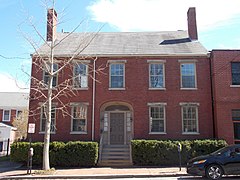
The Lord Block is a historic commercial building in downtown Lewiston, Maine. Built in 1865, it is one of downtown Lewiston's oldest commercial buildings, and a reminder of the city's early commercial character. The building was listed on the National Register of Historic Places in 1986.

The McLellan-Sweat Mansion is a historic house museum on High Street in Portland, Maine. It forms the rear component of the Portland Museum of Art complex. Built in 1800–01, the house was designated a National Historic Landmark in 1970 as a well-preserved Federal style brick townhouse.

Eastern Cemetery is a historic cemetery at the intersection of Washington Avenue and Congress Street in the East Bayside neighborhood of Portland, Maine. Established in 1668, it is the city's oldest historic site, and has more than 4,000 marked graves. It was listed on the National Register of Historic Places in 1973.
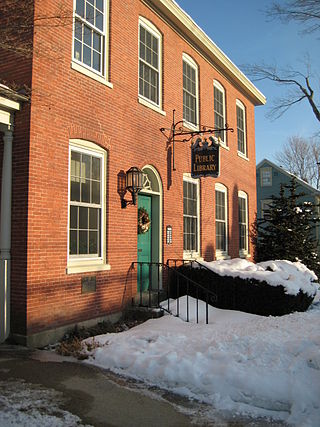
The Louis T. Graves Memorial Public Library is the public library of Kennebunkport, Maine. It is located at 18 Maine Street, in a handsome brick Federal style building that served as the U.S. Customhouse from 1815 until 1913. The building was listed on the National Register of Historic Places on January 18, 1974.

The Daniel How House is an historic house at 23 Danforth Street in Portland, Maine. Built in 1799, it is one of the oldest surviving residences on Portland's Neck, notably surviving the city's great 1866 fire. It is an excellent and well-preserved local example of Federal period architecture. It was listed on the National Register of Historic Places in 1973.

The Portland Packing Company Factory is an historic factory building at 14-26 York Street in Portland, Maine. It was added to the National Register of Historic Places in 1996. Built in 1884, it was home to Maine's oldest and largest vegetable canning company until 1927. After years of neglect, it was rehabilitated in 1995-6. It was listed on the National Register of Historic Places in 1996.

The Hamblen Block or Hamblen's Row is a historic series of four row houses at 188-194 Danforth Street in Portland, Maine, USA, Built in 1835, it is one of the oldest such buildings in the state, and also a rare example, as comparatively few row houses were built anywhere in the state. The row houses were added to the National Register of Historic Places in 1983, and are a contributing property to the larger Hamblen Development Historic District.
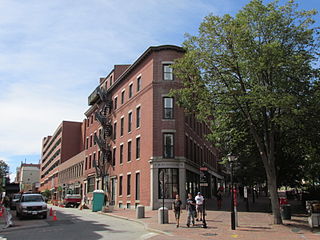
The Byron Greenough Block or Lower H. H. Hay Block is an historic commercial building at Free and Cross Streets in downtown Portland, Maine. Built in 1848 and enlarged in 1919 to a design by John Calvin Stevens, it is one of the city's finer surviving Greek Revival commercial buildings. The block was listed on the National Register of Historic Places in March 1977.

The Sawyer Building is a historic commercial building at 4-6 Portland Street in Dover, New Hampshire. The three-story brick structure was built in 1825, during Dover's period of economic prosperity following the establishment of its textile mills. It is one of Dover's oldest commercial buildings. The building was listed on the National Register of Historic Places in 1980.

The Hay Building is an historic commercial building on Congress Square in downtown Portland, Maine. It occupies a prominent triangular site at the junction of Congress, High and Free Streets. Built in 1826 to a design by prominent local architect and merchant Charles Q. Clapp, it is one of the oldest commercial buildings in Portland.
The Henry Knox Thatcher House is a historic house at Main and Elm Streets in Mercer, Maine. Built c. 1826, the building is a fine blend of late Federal and Greek Revival styling. It is most significant as the longtime home of Henry Knox Thatcher, an admiral in the United States Navy during the American Civil War. The property was listed on the National Register of Historic Places in 2002.
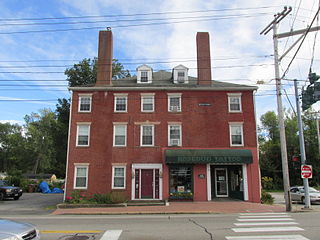
The Jacobs Houses and Store are a collection of three Federal-period historic buildings at 9-17 Elm Street in Saco, Maine. Built between 1820 and 1826, there are two similar wood-frame houses and a large brick commercial building, all associated with the Jacobs family, local businessmen. The buildings were listed as a group on the National Register of Historic Places in 1982.

The Old Post Office is a historic former post office building at 35 Washington Street in Biddeford, Maine. Built in 1914, it is a fine local example of Classical Revival architecture, and a prototype for post offices built in the following decades. The property was listed on the National Register of Historic Places in 1973. It now houses commercial offices.
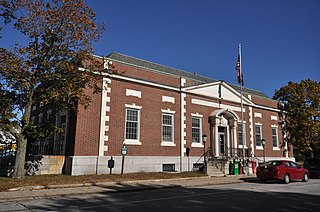
The U.S. Post Office-Sanford Maine is the main post office of Sanford, Maine. It is located at 28 School Street, near the city's central business district. Built in 1932 and enlarged to include other federal offices in 1965, it is an architecturally distinguished building with Classical and Colonial Revival features. The building was listed on the National Register of Historic Places in 1986.
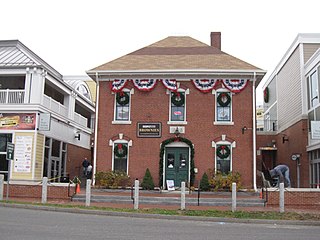
The E.B. Mallett Office Building is a historic commercial building on Mill Street in Freeport, Maine. Now part of the Freeport Village Station shopping complex, it is an 1888 Italianate brick building designed by Portland architect Francis Fassett for Freeport's leading businessman of the period. It was listed on the National Register of Historic Places in 1982.
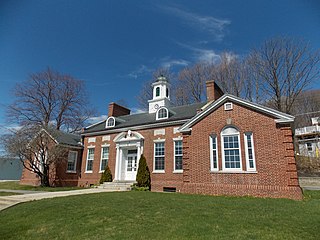
The Maine Publicity Bureau Building is a historic commercial building at 501 Danforth Street in Portland, Maine, United States. Built in 1936, it is a local example of Colonial Revival architecture and was listed on the National Register of Historic Places in 1990 for its association with early formalized efforts by the state to promote tourism.

The Marine Hospital is a historic medical facility at 331 Veranda Road on Martin's Point in Portland, Maine. Built in the late 1850s to a design by Ammi B. Young, it is the only known surviving Marine Hospital of the period to retain original iron railings. The building is now part of the Portland campus of the Martin's Point Health Care medical practice. It was listed on the National Register of Historic Places in 1974.

The Kresge Block is a historic commercial building at 241-249 Water Street in downtown Augusta, Maine. Built in 1932 to house a department store, it is a distinctive and rare local example of commercial Moderne architecture. It was listed on the National Register of Historic Places in 1986.

The Tappan-Viles House is a historic house at 150 State Street in Augusta, Maine. Built in 1816 and restyled several times, the house exhibits an eclectic combination of Federal, Italianate, and Colonial Revival styles, the latter contributed by architect John Calvin Stevens. The house was listed on the National Register of Historic Places in 1982; it is now part of a bank complex.

The Wiscasset Historic District is a 101-acre (41 ha) historic district that encompasses substantially all of the central village of Wiscasset, Maine. The district includes at least 22 contributing buildings and two other contributing sites, one being a cemetery whose oldest stone is from 1739. Located on the west bank of the Sheepscot River and settled in the 18th century, Wiscasset was a prominent harbor in Mid Coast Maine, and a major shipbuilding and merchant port, until the War of 1812 ended its prosperity. The village center includes fine examples of Federal period architecture, most built between about 1780 and 1820, including one National Historic Landmark, the Nickels-Sortwell House. The district was listed on the National Register of Historic Places in 1973.




